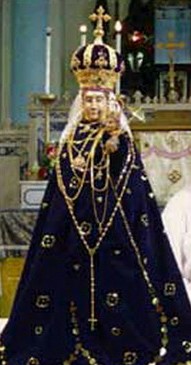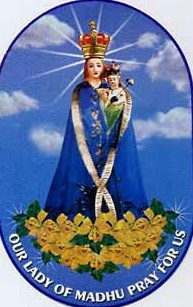Our Lady of Madhu
Our Lady of Madhu
Our Lady of Madhu, Sri Lanka
– Father Johann G. Roten, S.M.

The twenty-five-year-old bitter fighting between the Sri Lankan Government (predominately Sinhalese) and the separatist movement of the Tamil Tigers came to an end in May of 2009. The bloody conflict and civil war killed an estimated seventy-thousand people, many of them of the Catholic Faith.
The end of the civil war seems to signal the revival of the most celebrated shrines in Sri Lanka, namely that of Our Lady of Mahdu Matha, or Mother of Mahdu. Mahdu is a village 185 miles from the capital of Colombo--situated in the Northern region of the island of Sri Lanka. It harbors the miraculous image of Our Lady of Mahdu, believed to be as old as the beginnings of the Sri Lankan evangelization by Franciscan missionaries (Juan de Villa de Conde, 1543). The crowned and sumptuously clad statue (61 cm.) adorned with the crescent moon symbol of the Immaculata, features traits reminiscent of Guadalupe.
Originally located in the imposing Sanctuary of Mantai, center of the flourishing Christian community of Mantote, it was hidden during the Dutch (Protestant) persecution (Spanish-Dutch War of 1638-1658) in the wild jungle east of Mantai, in the region of what is now Mahdu. Image and pilgrimage experienced a long period of spiritual importance following famine and 'black death' (cholera) decimating the Sri Lankan population in 1868-78. The first annual feast day was celebrated on July 2, 1870. The present Basilica Church--construction began in 1872!--was consecrated in 1944. The crowning of the image took place on July 2, 1924. The Sanctuary is flanked by an artificial lake allowing for daily ablutions to up to one hundred thousand pilgrims and natives.
Our Lady of Mahdu--the statue was moved from the front lines during the last phase of the civil war--is renowned for its protective power not only in times of war, famine, and epidemic, but also in cases of snake bites, purportedly by preventing them. Venerated as the "Queen of Snakes" in a region infested by up to thirty different species of snakes, Our Lady is said to protect pilgrims against the dangers of the snakes' deadly poison. Tradition attributes a special healing quality and power to the soil of Mahdu--still another favor granted through the intercession of Our Lady. As for many other origins of Marian images, it is said that the statue of Our Lady of Mahdu was rediscovered in 1670, miraculously hidden in the trunk of a tree.
Maybe one of the most astounding characteristics of this Marian icon is its ecumenical appeal and outreach. Only about 7% of the Sri Lankan population, Sinhalese and Tamil, is Catholic, but the shrine attracts also Buddhist Sinhalese and predominately Hindu Tamils. The celebration of Assumption on August 15, 2009 drew, according to some news sources, up to five hundred thousand pilgrims bringing together Catholics, Buddhists and Hindus--Tamils as well as Sinhalese. This may be the most important miracle yet that we owe to Our Lady of Mahdu's intercession: that this venerated image of Mary can bring together all Sri Lankans.

All About Mary includes a variety of content, much of which reflects the expertise, interpretations and opinions of the individual authors and not necessarily of the Marian Library or the University of Dayton. Please share feedback or suggestions with marianlibrary@udayton.edu.
